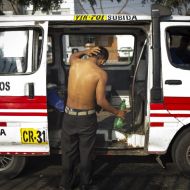The Wizards Behind the Curtain in Lima’s Totally Insane Bus System
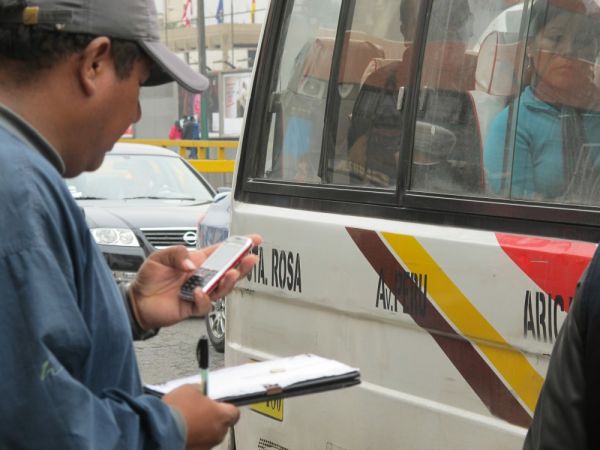
Dozens of bus drivers rely on the sharp eyes and memories of Lima’s dateros.
It’s fall in Lima and unusually warm when a beat-up white bus with red and orange stripes pulls up to a street corner at a busy intersection and allows passengers to scramble on board. A man wearing a short-sleeved button-down shirt and carrying a clipboard walks over to the passenger-side window and shouts at a string of coded numbers and words to the driver.
“Five, seven, five!” the datero yells, followed by words that are virtually indecipherable to anyone not employed in the transportation business.
Once the final passenger is on board, the bus peels away from the corner, and the cobrador, or fare collector, flicks a bronze-colored 20 cent coin into the air, which the datero reaches out to catch, but misses.
This is a moment of choreographed chaos that occurs hundreds of times each day in the streets of Lima. Amid the intense competition of the city’s informal bus system, the dateros are the timekeepers and the main source of information for 32,000 bus drivers who would be operating totally in the dark without them. They are known by several titles (datero, dateador, marcador) but all carry out the same function: They relay information to the drivers and cobradors. Their intel is both simple and critical – dateros tell drivers how many buses are ahead of them, how far ahead, how spread out they are, and how many passengers they’re carrying, so the drivers can decide whether to speed up or slow down.
It’s a bewildering, awe-inspiring, ultimately ridiculous system that’s absolutely crucial to preventing the city from grinding to a halt, for the vast majority of Lima’s public transit is informal. With an average of 28 different bus companies competing for passengers on any given kilometer of a typical bus route, the dateros keep these buses from either overcrowding or running half-full.
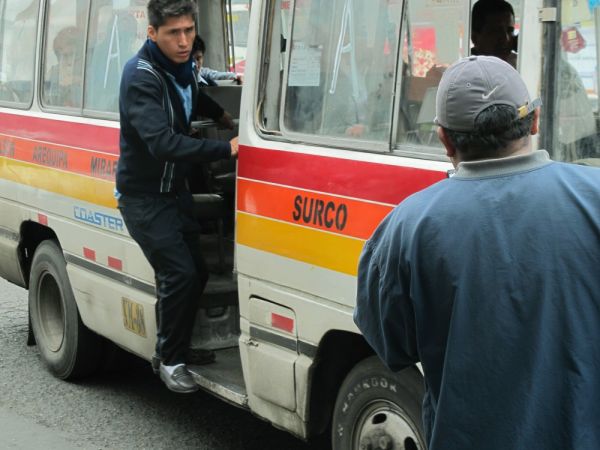
Cobradores pay dateros who relay information about the positions of other buses along the route.
“Its simple,” says Yuri, a short, stocky 28-year-old datero who’s been on the job for close to two years. “You just need to be alert.”
A man of few words, as we talk Yuri constantly glances at his digital watch and records the times that buses roll past his corner. His clipboard holds a small stack of white gridded paper, on which a tiny scrawl of black ink holds information about the day’s buses, written in a shorthand system.
As buses approach, Yuri runs over and shouts something that explains how far apart the buses are and how many passengers they’re carrying. In exchange for this information he gets handed a 20 cent coin (about $0.07 USD) from each cobrador.
He got his start as a datero though a family member who would occasionally let Yuri cover for him. He now works the streets most days, and says the small bronze-colored coins add up. “This is my job full time, I live off this,” he says, peering down the street for the next bus.
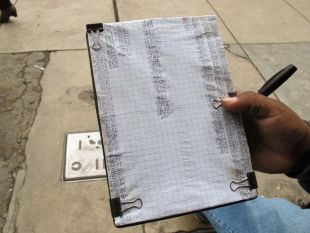
Yuri keeps notes in shorthand.
Along some of the most transited routes, dateros work alongside so-called “formal” dateros, who are employed by the bus companies, and only keep track of the buses that belong to that company. They can be told apart by the vests they wear, which usually bear the bus company’s logo. These formal dateros use cell phones to keep in touch with coworkers along the route, and also work as a type of timecard, ensuring drivers stay on their designated route and schedule.
But like most dateros, Yuri works independently, which means he can monitor several different bus lines, and the money he collects every day goes straight into his pocket, tax free. How much he makes depends on how many lines he’s keeping track of that day, but it usually tops out at around 40 soles. “I’ve monitored up to 13 [lines],” he says, but after moving to a different street over a year ago, he’s gone down to eight. When things slow down he takes a seat at the side of the road on a green plastic chair he brings with him to work each day.
Keeping track of the buses is only half the work. The tricky part is in communicating this information to the drivers in the time it takes for the passengers to disembark from the bus. That’s why dateros have what seems like their own secret language. When a datero says, “Five, seven, five,” he is telling the cobrador about the gaps between his bus and the buses further ahead. His bus is five minutes behind the last bus, twelve minutes behind the one before that one, and seventeen behind the one before that.
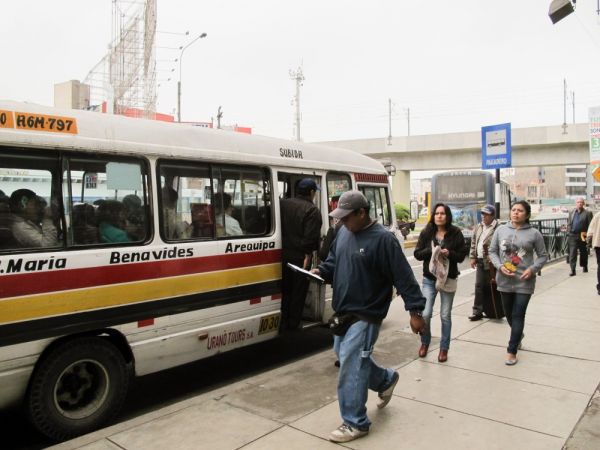
Lima’s bus system is chaos, but it would be even crazier without its dateros.
After working on the same street for over a year, Yuri is on a first name basis with most of the cobradores, and has nicknames for many of them. Although he seems at ease on the street, he says the job requires plenty of mental exertion. When he feels there is a far enough gap between buses, he’ll take a short break and slump down in his green plastic seat.
“The competition is hard, so you have to fight it out for every passenger,” he says, referring to the drivers. “We help them with that.”
Just then a bus pulls up to the corner, and Yuri leaps up from his seat, looking at his watch and spouting off yet another indecipherable code. As the bus takes off the cobrador throws a coin in the air, which Yuri deftly catches with his clipboard. He smiles.
Photos by Manuel Vigo






